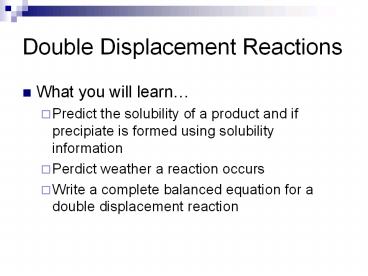Double Displacement Reactions - PowerPoint PPT Presentation
1 / 15
Title:
Double Displacement Reactions
Description:
Double Displacement Reactions What you will learn Predict the solubility of a product and if precipiate is formed using solubility information – PowerPoint PPT presentation
Number of Views:871
Avg rating:3.0/5.0
Title: Double Displacement Reactions
1
Double Displacement Reactions
- What you will learn
- Predict the solubility of a product and if
precipiate is formed using solubility information - Perdict weather a reaction occurs
- Write a complete balanced equation for a double
displacement reaction
2
Solubility
- The solubility of a solute is the amount that can
be dissolved in a given quantity of solvent at a
given temperature. - e.g. Pb(NO3)2 is 56 g/100 mL H2O at 20C.
- It is temperature and pressure dependent
- Three categories soluble, slightly soluble,
and insoluble.
3
Solubility Rules and Double Displacement Reactions
- A double displacement reaction occurs if a
precipitate forms, a gas is produced or a
molecular compound like water is created. - Solubility rules can used to determine if a
reaction will occur in a double displacement
reaction. - If both the products are soluble (form ions in
solution), then no reaction has occurred.
4
Double Displacement Reaction
3CoCl2(aq) 2Na3PO4(aq) ? Co3(PO4)2(s)
6NaCl(aq)
Will this reaction occur?
- A reaction will occur only if the following will
be produced - Gas
- Solid precipitate
Solubility table
5
Forming an Insoluble Product
Pb(NO3)2(aq) 2KI(aq) ? PbI2(s) 2KNO3(aq)
6
Solubility Rules (common ionic compounds in water
at 25 ?C)
7
Verifying Solubility
- Use your solubility chart to verity if the
compound is soluble in water? - MgCO3
- AgNO3
- MgCl2
- Na3PO4
- KOH
8
Solubilities Not on the Table!
- Gases only slightly dissolve in water
- Strong acids and bases dissolve in water
- Hydrochloric, Hydrobromic, Hydroiodic, Nitric,
Sulfuric, Perchloric Acids - Group I hydroxides (should be on your chart
anyway) - Water slightly dissolves in water! (H and OH-)
- SrSO4 is insoluble BeI2 and the products are
soluble - There are other tables and rules that cover more
compounds than your table!
9
Solubility Table
10
Double Displacement Reactions that Produce a Gas
- One product of the double displacement decomposes
to give WATER and a GAS - This type has two steps
- 1. The double displacement
- 2. The decomposition of one of the products of
double displacement to form water and a gas. - Steps to solving double displacement reactions
that produce a gas - Perform the double displacement
- Na2CO3(aq) HCl(aq) ? NaCl(aq)
H2CO3(aq)
(Very unstable so it decomposes). - 2. Perform the decomposition convert the
unstable compound into water and a gas.
H2CO3(aq) ? H2O (l) CO2(g) (Recall from
decomposition reactions Acid ? Non-metal oxide
and water.) Trick 1st subtract water from the
formula of the acid H2CO3 H2O CO2 (take out
2 H and one O) - 3. Rewrite the original reaction and replace the
acid in the original equation by water and the
gas produced. Na2CO3(aq) HCl(aq) ? NaCl(aq)
H2O (l) CO2(g)
11
Double Displacement Neutralization
- Neutralization Reaction A special type of double
displacement reaction that produces water and a
salt. - General Equation Acid (Usually has H) Base
(usually has OH) ? Water Ionic Comp. (a salt
ionic compound produced by a neutralization
reaction) - Sample Problems
- e.g. NaOH(aq) HCl(aq) ? NaCl(aq) H2O(l)
- HNO3(aq) NaOH(aq) ? _______________________
- KOH(aq) H2SO4(aq) ?________________________
- SrO(s) HBr(aq) ? ____________________________
12
Predicting the Products for a Chemical Reaction
H2O2 ? ?
2) Is there only ONE reactant?
If yes, then this reaction is a DECOMPOSITION
REACTION
So there should be two products, each being a
separate element (i.e. Na, Ca, O2, I2, Br2)
although that is not always the case
2H2O2 ? 2H2O O2
13
Predicting the Products for a Chemical Reaction
Zn SnCl2 ? ?
3) If there are 2 reactants, is one of them a
pure metal on its own?
If yes, then this reaction is a SINGLE
DISPLACEMENT REACTION
So the metal that is on its own must take the
place of the other metal that is in the larger
compound
Zn SnCl2 ? ZnCl2 Sn
14
Predicting the Products for a Chemical Reaction
NaCl AgNO3 ? ?
4) Are both of the reactants compounds?
If yes, then this reaction is a DOUBLE
DISPLACEMENT REACTION
So the two metals must switch places with one
another, forming two new compounds
NaCl AgNO3 ? NaNO3 AgCl
15
Predicting the Products for a Chemical Reaction
C8H18 O2 ? ?
5) Is one of the reactants oxygen gas?
If yes, then this reaction is a COMBUSTION
REACTION (as well as a SYNTHESIS REACTION)
So the products must be an oxide and energy. If
one of the reactants is a hydrocarbon, then CO2
H2O are the products.
2C8H18 25O2 ? 16CO2 18H2O energy


























![Chem 111 Chapter 3 [ Kotz] Chemical Reactions Highlights PowerPoint PPT Presentation](https://s3.amazonaws.com/images.powershow.com/5024369.th0.jpg?_=20140412048)




